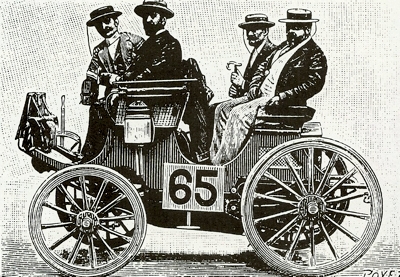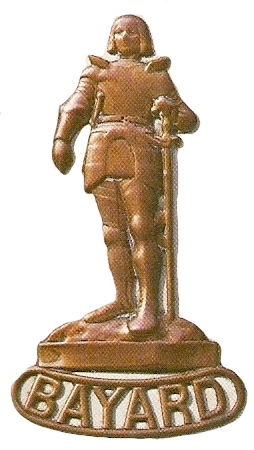GUSTAVE-ADOLPHE CLEMENT, a locksmith and son of a locksmith, was born at Pierrefonds, Oise, in 1855. He soon decided, however, that he was destined for wider horizons, so bundled a few possessions into a handkerchief and set off tramping round France, living off the proceeds of his trade.
By 1878 he had established himself in a workshop right at the centre of the Parisian velocipede industry. Bitten by the cycling bug, Clement began entering races and repairing the wood-and-iron boneshakers and high-wheeled 'ordinaries' of the period.
He then moved into cycle manufacture, and would become reasonably successful. People referred to his almost uncanny ability to forecast future market trends: in 1891, he acquired sole French rights to the Dunlop pneumatic tyre.
Experts claimed that these 'pudding wheels' could never replace solid rubber tyres, but Clement proved them wrong, and the company he formed with a capital of 700,000 francs paid 100 per cent dividend in its first year of operation.
He used some of his money to back his old friend Alexandre Darracq in founding the Gladiator cycle company, at Pre-Saint-Gerbais. The Gladiator machines soon earned a reputation for speed and reliability.
The Mineral Naphtha Tricycle
In 1895, the company made its first venture into internal combustion with a 'mineral naphtha' tricycle. During the next year, Clement was instrumental in floating the Clement-Gladiator-Humber (or 'Clediaber') combine for 22 million francs. The Humber interest was soon dropped and, in 1898, the new Clement-Gladiator company began building cars, known indifferently as Clements or Gladiators. Though the products of the two companies soon diverged, Harvey Du Cros of the English Dunlop company was one of those promoting the Clement-Gladiator venture and the Motor Power Company, owned by Du Cros and S. F. Edge, imported Gladiators into England.
In 1897, Clement had helped capitalise Panhard & Levassor for five million francs (of which he actually put in one million). Then Commandant Krebs, of Panhard, designed, and Clement built under licence, a curious four-wheeled car. Fortunately for Commandant Kreb's reputation as an engineer, he is remembered for the excellent automatic carburettor that he also designed, rather than for the Clernent-Panhard, which was a dog's breakfast of archaisms. It had centre-pivot steering, like a cart, and a rear-mounted single-cylinder engine with automatic inlet valve and hot-tube ignition; early models were devoid of reverse gears, too.
The Stirling Dogcart
Despite its utalitarian nature, the machine was widely copied. Stirling in Scotland built it as the Stirling-Panhard, Clement-Stirling or Stirling Dogcart, while Ariel made it under the name Ariel-Panhard. Alongside this machine, Clement produced a light voiturette with a 2t hp De Dion engine geared to the rear axle; both types were produced in the new factory that Clement had built at Levallois-Perret, Seine, on the site of the velodrome he had constructed during the bicycle boom to promote the sporting achievements of his products. Other factories were established at Tulle and at Mezieres.
 This is a picture, showing Adolphe Clement (second from left), taking part in the Paris-Rouen race in a tiller steered Peugeot. This is a picture, showing Adolphe Clement (second from left), taking part in the Paris-Rouen race in a tiller steered Peugeot.
 Founded in 1903 by Adolphe Clement, the Clement-Bayard produced this runabout prior to World War 1, a war that Clement warned was coming, and for which he was attacked when visiting Germany in 1912. Founded in 1903 by Adolphe Clement, the Clement-Bayard produced this runabout prior to World War 1, a war that Clement warned was coming, and for which he was attacked when visiting Germany in 1912. |
Coupe de l'Auto Race Series
Around this period, Clement collaborated with the Marquis de Dion in founding l' Auto, an exceptionally successful daily motoring paper, which was later to promote the Coupe de l'Auto race series. At the end of 1901, more conventional cars, 7 hp singles and 12 hp twins, were in production. The designer was Marius Barbarou, who was soon lured away to Germany to design a new range for Benz to replace the outmoded rear-engined, belt-driven models that the reactionary Karl Benz would not abandon.
Within a couple of years, the Clement range had been developed still further, consisting of 9, 12 and 16 hp cars, the larger two being four-cylinder models with automatic inlet
valves. Their chassis design was now virtually identical to that of the Gladiator (at that time built in the same factory) except that Clements had shaft drive, whereas Gladiators still used chains. Then, in October 1903, it was announced that Adolphe Clement had parted from the Clement-Gladiator Company, which had come under the control of Harvey Du Cross.
A condition of the deal was that Adolphe Clement lost the right to call his cars Clements, although in view of the subsequent goings-on, which had the nonsensical complexity of a French bedroom farce, it is possible that Clement managed to keep some control over Clement-Gladiator. First there was the restriction on using his own name; rather than change the clause in the contract, he changed his name.
Bayard, 'Le chevalier Sans Peur et Sans Reproche
In the main courtyard of his factory at Mezieres stood a statue of Bayard, 'Le chevalier sans peur et sans reproche', who had saved the French Army from defeat by the Duke of Nassau, in 1521. Clement had taken this as his trademark, and now received government permission to change his name to Clement-Bayard. Now a new range of Clernent-Bayard cars, suspiciously similar to the old Clement-Gladiators, was announced. The new models were sold in Britain by a new company called Clement-Talbot .Ltd, under the directorship of the Earl of Shrewsbury & Talbot.
The company was managed by the bombastic Danny Weigel, who had driven a Clement in the 1902 Paris-Vienna race, but within a year this marque had become all British and the cars just Talbots. Not so the other marques fathered by Monsieur Clement-Bayard, and in 1906 a company was set up in Coventry to build Gladiators under licence. Perversely it was called the Clement Motor Company ('Simply Clement, nothing else', they reminded customers, to avoid confusion with Clement-Talbot).
Some 1908 Austins were English-built Gladiators (or vice versa), while the continued import of French Gladiators served only to confuse matters still further, for Gladiator also had connections with Vinot-Deguingand, and certain Gladiator and Vinot models were identical. In Turin, Diatto-Clements appeared in 1907 to give an added twist to the plot, while one suspects that Clernent-Bayard's son-in-law, motor manufacturer Fernand Charron, borrowed the old man's designs for his new 1909 models. Some Darracq designs seemed to also have the Clernent-Bayard touch.
Adolphe Clement-Bayard's aeronautical activities should not be forgotten: he owned the Astra Aeronautical establishment, where the highly successful Clement-Bayard airships were built; his, too, was the first mass-produced popular light aeroplane, the Clernent-Bayard Demoiselle, built to the design of Alberto Santos-Dumont, the Brazilian aviation pioneer and there were the famous Bayard-Clement aero engines, too (the power units for the airship, Clement-Bayard II, developed 220 hp, had crankshafts six feet long and had pistons as big as a man's head!).
 The badge of the Clement Bayard, modelled on a statue of Bayard, a soldier who had saved the French army from defeat by the Duke of Nassau in 1521. The badge of the Clement Bayard, modelled on a statue of Bayard, a soldier who had saved the French army from defeat by the Duke of Nassau in 1521.
|
Clement-Bayard cars appeared regularly in competition, even continuing after Albert, son of the marque's founder, was killed in practice for the 1907 French
Grand Prix on the Dieppe circuit. The 13,966 cc., single-overhead-camshaft 1908
Grand Prix Clernent-Bayards were the fastest and most spectacular cars in the race but the new Mercedes racers were too good and gained the first three places, leaving fourth to Rigal's 120 mph Clement-Bayard.
In 1907, the Clernent-Bayard works, which were managed by M. S. Guillemon, introduced a 1.6-litre, 10/12 hp model, which had the advanced feature of a monobloc engine in unit with the gearbox, plus a Renault-style dashboard radiator, which was to be a characteristic of the marque until 1914. Though large cars continued to be made, it was this type of high-quality light car which characterised the subsequent history of Clernent-Bayard; by 1911 design had diverged markedly from the English Talbot, and the cars were reintroduced to the British market.
By then Adolphe Clement-Bayard's public image had become more important to him than his motor manufacturing activities, and as early as 1910 he had been warning the French people of the warlike ambitions of the Germans. He became so vociferous that, when he visited Germany in 1912, he was assaulted by a hostile mob. When war came, he was a marked man.
In September 1914, the Germans reached the outskirts of Pierrefonds and shelled Clernent-Bayard's country estate. Fortunately, the owner, who had recently retired, was not at home. After the war, Clement-Bayard cars went into a gentle decline. Still well-built, they became utterly conventional. Only two models, of 8 hp and 17.6 hp, were built and by 1922 the marque's sole remaining factory was taken over by the up-and-coming Andre Citroen for the manufacture of spare parts.
As for the marque's founder, he did not long outlive the cars, On the 11th May 1928, he was driving through Paris, on his way to a business meeting, when he had a stroke and died. Though Adolphe Clernent-Bayard had always proved himself sans peur in his complex business affairs, these affairs were apparently not always sans reproche. It was as a patriot, however, and as a pioneer of the motor industry, that France mourned him.
Also see: Honour Roll - Founding Fathers Of The Automotive Industry


